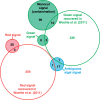Re-evaluating the green versus red signal in eukaryotes with secondary plastid of red algal origin
- PMID: 22593553
- PMCID: PMC3516247
- DOI: 10.1093/gbe/evs049
Re-evaluating the green versus red signal in eukaryotes with secondary plastid of red algal origin
Abstract
The transition from endosymbiont to organelle in eukaryotic cells involves the transfer of significant numbers of genes to the host genomes, a process known as endosymbiotic gene transfer (EGT). In the case of plastid organelles, EGTs have been shown to leave a footprint in the nuclear genome that can be indicative of ancient photosynthetic activity in present-day plastid-lacking organisms, or even hint at the existence of cryptic plastids. Here, we evaluated the impact of EGT on eukaryote genomes by reanalyzing the recently published EST dataset for Chromera velia, an interesting test case of a photosynthetic alga closely related to apicomplexan parasites. Previously, 513 genes were reported to originate from red and green algae in a 1:1 ratio. In contrast, by manually inspecting newly generated trees indicating putative algal ancestry, we recovered only 51 genes congruent with EGT, of which 23 and 9 were of red and green algal origin, respectively, whereas 19 were ambiguous regarding the algal provenance. Our approach also uncovered 109 genes that branched within a monocot angiosperm clade, most likely representing a contamination. We emphasize the lack of congruence and the subjectivity resulting from independent phylogenomic screens for EGT, which appear to call for extreme caution when drawing conclusions for major evolutionary events.
Figures




Similar articles
-
Eukaryote-to-eukaryote gene transfer gives rise to genome mosaicism in euglenids.BMC Evol Biol. 2011 Apr 18;11:105. doi: 10.1186/1471-2148-11-105. BMC Evol Biol. 2011. PMID: 21501489 Free PMC article.
-
Genomic footprints of a cryptic plastid endosymbiosis in diatoms.Science. 2009 Jun 26;324(5935):1724-6. doi: 10.1126/science.1172983. Science. 2009. PMID: 19556510
-
A common red algal origin of the apicomplexan, dinoflagellate, and heterokont plastids.Proc Natl Acad Sci U S A. 2010 Jun 15;107(24):10949-54. doi: 10.1073/pnas.1003335107. Epub 2010 Jun 1. Proc Natl Acad Sci U S A. 2010. PMID: 20534454 Free PMC article.
-
The endosymbiotic origin, diversification and fate of plastids.Philos Trans R Soc Lond B Biol Sci. 2010 Mar 12;365(1541):729-48. doi: 10.1098/rstb.2009.0103. Philos Trans R Soc Lond B Biol Sci. 2010. PMID: 20124341 Free PMC article. Review.
-
What was the real contribution of endosymbionts to the eukaryotic nucleus? Insights from photosynthetic eukaryotes.Cold Spring Harb Perspect Biol. 2014 Jul 1;6(7):a016014. doi: 10.1101/cshperspect.a016014. Cold Spring Harb Perspect Biol. 2014. PMID: 24984774 Free PMC article. Review.
Cited by
-
Metabolic Innovations Underpinning the Origin and Diversification of the Diatom Chloroplast.Biomolecules. 2019 Jul 30;9(8):322. doi: 10.3390/biom9080322. Biomolecules. 2019. PMID: 31366180 Free PMC article. Review.
-
Cryptic organelle homology in apicomplexan parasites: insights from evolutionary cell biology.Curr Opin Microbiol. 2013 Aug;16(4):424-31. doi: 10.1016/j.mib.2013.07.015. Epub 2013 Aug 8. Curr Opin Microbiol. 2013. PMID: 23932202 Free PMC article.
-
Algal genomes reveal evolutionary mosaicism and the fate of nucleomorphs.Nature. 2012 Dec 6;492(7427):59-65. doi: 10.1038/nature11681. Epub 2012 Nov 28. Nature. 2012. PMID: 23201678
-
Horizontal gene transfer and redundancy of tryptophan biosynthetic enzymes in dinotoms.Genome Biol Evol. 2014 Feb;6(2):333-43. doi: 10.1093/gbe/evu014. Genome Biol Evol. 2014. PMID: 24448981 Free PMC article.
-
Single cell genomics reveals plastid-lacking Picozoa are close relatives of red algae.Nat Commun. 2021 Nov 17;12(1):6651. doi: 10.1038/s41467-021-26918-0. Nat Commun. 2021. PMID: 34789758 Free PMC article.
References
-
- Abrahamsen MS. Complete genome sequence of the apicomplexan, Cryptosporidium parvum. Science. 2004;304:441–445. - PubMed
-
- Archibald JM. The puzzle of plastid evolution. Curr Biol. 2009;19:R81–R88. - PubMed
-
- Bowler C, et al. The Phaeodactylum genome reveals the evolutionary history of diatom genomes. Nature. 2008;456:239–244. - PubMed
Publication types
MeSH terms
LinkOut - more resources
Full Text Sources
Research Materials
Miscellaneous

